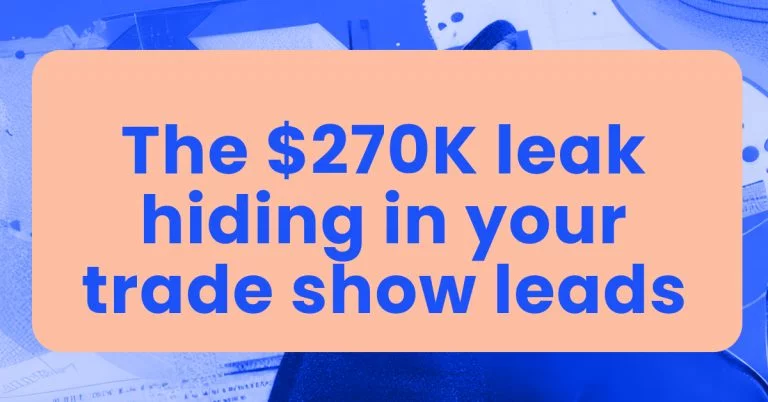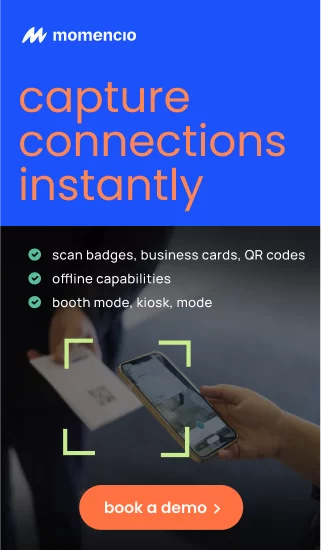For any event planner or marketer, knowing how well an event performed financially is not just a nice-to-have—it is a necessity. Understanding your event’s ROI helps you measure its effectiveness, justify the budget, and identify areas for improvement. Without solid ROI metrics, you are left making guesses about what worked and what did not.
But calculating event ROI goes beyond just adding up costs and revenue. A truly effective analysis helps you dig deeper into the finer details—how much profit did the event generate? Which areas of the budget delivered the most value? And how did the technology you used contribute to the event’s overall success?
That is where momencio’s suite of ROI calculators comes in. These tools give you a simple way to measure the full financial impact of your event. With the simple event ROI calculator, you get a broad overview of how much value your event created. The event profit & cost ROI calculator allows you to dive into specific expense areas, while the event API cost impact calculator helps you evaluate the effectiveness of integrating technology into your event setup.
Each of these calculators plays a unique role, but when used together, they provide a complete picture of your event’s financial performance. In this article, we will explore how each tool works, explain how to use them, and show you how to leverage the data they provide to make smarter, more informed decisions for your next event.
Understanding the three calculators and their unique roles
When it comes to calculating event ROI, momencio provides a powerful trio of tools designed to give you both a high-level view and a detailed breakdown of your event’s financial performance. Each calculator serves a specific purpose, but together, they offer a comprehensive look at how well your event performed and where you can improve.
1. Simple event ROI calculator
The simple event ROI calculator is the main tool that gives you a big-picture view of your event’s financial performance. It calculates the overall return on investment by comparing the total revenue generated by the event to the total costs. This tool is perfect for quickly understanding whether your event was profitable or not, and by how much.
You will input basic details such as your total event costs and expected or actual revenue. The calculator will then display the profit and ROI percentage, showing how much return you gained for every dollar spent. This is the first step in understanding how well your event performed, but it only scratches the surface.
2. Event profit & cost ROI calculator
While the event ROI calculator gives you the headline figures, the event profit & cost ROI calculator goes deeper. This tool helps you break down and track specific expenses, such as venue rental, catering, marketing, and technology. You can categorize your costs and see exactly where your money went, and more importantly, which areas generated the most value.
This level of detail allows you to analyze your profit margins and see which parts of your event delivered the best returns. For example, you may find that while your overall event was profitable, certain areas of your budget were less efficient. This insight helps you refine your planning for future events, ensuring your resources are spent wisely.
3. Event API cost impact calculator
In today’s events, technology plays a significant role in shaping the attendee experience and driving event success. The event API cost impact calculator focuses on evaluating the effectiveness of the event technology you used. This tool calculates the return on investment for APIs and other tech integrations, such as attendee engagement platforms, lead capture systems, and real-time analytics tools.
By calculating the costs of these technologies and comparing them to the benefits they bring—such as increased lead generation, better attendee insights, or improved operational efficiency—you can see whether your event tech stack is adding enough value to justify its cost. In a world where technology can make or break an event, this kind of insight is invaluable.
With these three calculators, you have the ability to measure your event’s performance from multiple angles. The simple event ROI calculator gives you a clear snapshot of overall success, the profit & cost ROI calculator helps you optimize specific budget areas, and the event API cost impact calculator ensures your technology investments are paying off.
Measure and optimize event profitability
momencio’s suite of calculators provide a complete, multi-layered understanding of your event’s ROI:
- Start with the event ROI calculator for a big-picture understanding of profitability.
- Dive into specific costs using the event profit & cost ROI calculator to track how each expense contributed to overall profits.
- Assess the value of your API integrations with the event API cost impact calculator, to understand the cost-benefit ratio of incorporating APIs into your event.
Armed with these insights, you can plan future events with confidence, knowing exactly where to allocate resources for maximum ROI.

How to use the single event ROI calculator: A step-by-step guide
momencio’s simple event ROI calculator makes it easy to evaluate how much value your event generates. This event ROI calculator is a powerful tool for event planners and marketers looking for a quick, high-level snapshot of their event’s profitability. Here is a detailed step-by-step guide to help you make the most out of the tool.
-
Input the number of events
Start by entering the total number of events you are analyzing. This field allows the calculator to process multiple events simultaneously, giving you an aggregated ROI for all the events under review.
-
Enter the cost per event
For each event, input the total cost, which should cover both direct and indirect expenses. this could include:
- Venue rental: Cost of renting the event space.
- Marketing costs: Paid advertising, email marketing, social media campaigns, etc.
- Staffing costs: Wages for on-site staff, including temporary hires.
- Miscellaneous costs: Signage, printing, transportation, and other logistics.
Being thorough with your cost input ensures the ROI calculation is as accurate as possible.
-
Include the technology costs per event
Many events rely heavily on technology for attendee engagement, lead capture, and analytics. You need to enter the tech costs for each event, which could include:
- Lead capture app to gain contact details and track interactions.
- Audio-visual equipment could include microphones, speakers, projectors, rental or purchase, etc.
These costs are vital for assessing whether your event tech investments are providing sufficient returns.
-
Input revenue generated per event
Next, input the revenue generated per event, which can include:
- Ticket sales: If your event sold tickets, include the total revenue here.
- Sponsorship revenue: Money earned from sponsors of the event.
- Exhibitor fees: Fees collected from exhibitors or vendors at trade shows.
If you are calculating ROI before the event, you can input expected revenue. For post-event analysis, enter the actual revenue.
Analyze your results
The final step is interpreting the results. A positive ROI means your event is expected to generate more money than it costs, which is a good indicator of success. A negative ROI, on the other hand, might suggest areas where costs were too high or revenue generation efforts might fall short.
This simple event ROI calculator gives you a clear overview of your event’s financial performance and serves as a foundation for deeper analysis using more detailed calculators like momencio’s profit & cost ROI calculator or event API cost impact calculator, which allow you to explore profit margins, cost breakdowns, and the value of technology integrations.
How to use the event profit & cost calculator to track specific event expenses
While the simple event ROI calculator offers a high-level view of your event’s success, the event profit & cost ROI calculator helps you dive deeper into the specific financial details. This tool provides a more granular analysis, enabling you to evaluate individual cost elements and better understand the profitability of your event. Here is how to use it:
-
Input the number of leads
Begin by estimating the number of leads generated per event. this could be attendees who registered for the event, participated in a session, or interacted with your team at a booth. Lead numbers are critical for understanding how much revenue the event has the potential to generate.
-
Enter the price per lead
Next, input the price per lead. If your event involves paid registration, you can use the ticket price here. For trade shows or conferences, this might also represent the expected value of each lead based on past conversion rates.
-
Track event income
The total income is automatically calculated by multiplying the number of leads by the price per lead. This figure represents the event’s primary source of revenue. If your event has multiple revenue streams, such as exhibitor fees or sponsorship deals—these can be included in this section as well.
-
Input detailed event expenses
Now, break down the specific expenses associated with your event. This is where you get into the nitty-gritty of costs, ensuring a thorough understanding of where your money is going. The calculator includes categories for:
- Venue costs: The total cost of renting the event space.
- Platform costs: If your event used a virtual or hybrid event platform, include the subscription or usage fees here.
- Marketing Costs: Any expenses related to advertising, social media campaigns, email marketing, and other promotional efforts should be added here.
Make sure to include any other relevant expenses, such as catering, audiovisual equipment, or additional staffing costs. This gives you a complete picture of your event’s financial layout.
This level of detail allows you to assess the efficiency of your event’s spending. You will be able to see which areas of your budget delivered the most value and which might need trimming or reallocating in the future.
Interpret your results for better budget planning
A positive cost ROI suggests that your event is poised to generate more revenue than it costs to execute. However, if the ROI is lower than expected, you may want to reassess specific expense categories. For example, if your marketing spend was high but did not generate many leads, this could indicate the need for a different strategy for the upcoming events.
Using the event profit & cost ROI calculator, you gain a deeper understanding of your event’s financial landscape. It goes beyond just total revenue and costs, offering insight into individual expense categories and their impact on overall profitability. With this detailed breakdown, you can make more informed decisions about where to cut costs, where to invest more, and how to maximize profits in future events.
How to use the event API cost impact calculator
momencio’s event API cost impact calculator is designed to help you assess how much value your API integrations bring to your event. APIs connect various event management systems, such as lead capture tools and CRM software, to ensure smooth data flow and efficient operations. However, these integrations come with costs that need to be evaluated to ensure they contribute positively to your event’s profitability.
Here’s a step-by-step guide on how to use this calculator:
-
Input the approximate number of events
Begin by using the slider to pick the number of events you are seeking to analyze. If you are calculating ROI for multiple events that used similar technology, this feature allows you to assess the aggregated impact of API costs and revenue across all events.
-
Enter total event cost (excluding API)
Next, input the total event cost, which includes all expenses except for the costs associated with API integration. This can include:
- Venue rental
- Marketing expenses
- Staffing costs
- Logistics and operations
By excluding API costs here, you get a clearer breakdown of how other event expenses contribute to overall profitability.
-
Input the cost of API integration
Now, enter the API integration costs. This includes all the fees associated with implementing and maintaining API connections during your event, such as:
- Costs for integrating your event platform with lead management tools.
- Fees related to connecting registration systems with your CRM.
- Support and maintenance fees for API usage.
This helps you quantify the financial outlay specifically tied to your technology investments.
-
Enter total event revenue generated
The next step is to input the total revenue generated by your event. this could include:
- Ticket sales
- Sponsorship income
- Exhibitor fees
- Revenue generated from products or services sold at the event
This figure provides the basis for calculating overall profitability before factoring in the contributions from API technology.
-
Input revenue from API integration
In this field, input the revenue specifically attributable to API integrations. This is a critical step because it allows you to assess the direct financial impact of the technology. Consider revenue sources like:
- Sales generated from follow-up activities enabled by API-driven attendee data capture solution.
- Increased sponsorship opportunities due to better engagement analytics.
Analyzing your API impact ROI
Once all the values are entered, the event API cost impact calculator will automatically compute the API impact ROI. This shows how much return you gained from integrating technology into your event operations.
The result from this event ROI calculator helps you understand whether your API investments provided a positive return. A high API ROI indicates that your technology integrations significantly contributed to event profitability. A low or negative ROI may suggest that your API costs outweighed their benefits, prompting a review of your tech stack.
Conclusion
Calculating event ROI is no longer a guessing game.
With tools like momencio’s simple event ROI calculator, event profit & cost ROI calculator, and event API cost impact calculator, event planners and marketers can get a comprehensive view of how well their events are performing financially. These calculators take the guesswork out of evaluating event success by giving you clear metrics and actionable insights.
FAQs
- What is the difference between the simple event ROI calculator and the event profit & cost ROI calculator?
- The simple event ROI calculator provides a quick, high-level overview of your event’s profitability by comparing total costs against total revenue. It gives you a broad understanding of whether your event was financially successful. On the other hand, the event profit & cost ROI calculator offers a more detailed breakdown of your event’s finances. It allows you to track specific expenses, such as venue costs, marketing spend, and technology fees, and see how each contributes to the event’s overall profit. This granular view helps you refine your budgeting strategies for future events.
- How does the event API cost impact calculator help improve event profitability?
- The event API cost impact calculator helps you measure the financial return of your technology investments, particularly API integrations. It quantifies how much value APIs add to your event, whether through automating lead capture, improving attendee engagement, or enhancing operational efficiency. By evaluating both the costs and the revenue generated through APIs, you can determine whether your tech investments are worth continuing or need to be adjusted to maximize profitability.
- Can these event ROI calculators be used for virtual or hybrid events?
- Yes, all three event ROI calculators can be used to evaluate in-person, virtual, or hybrid events. you can adjust cost inputs to reflect the specifics of virtual platforms, online attendee engagement tools, or hybrid technologies. For virtual events, platform fees and technology costs will play a larger role in the calculators, while venue costs may be reduced or omitted altogether.
- How can I ensure my ROI calculations are accurate?
- Accuracy in ROI calculations depends on how detailed and realistic your inputs are. Ensure that you account for all event costs, both direct (venue, staff, marketing) and indirect (technology, post-event follow-up). Additionally, include all revenue streams, such as ticket sales, sponsorships, and exhibitor fees. If your event is still in the planning stage, make sure your revenue estimates are conservative and based on past data whenever possible. For technology assessments, be clear on the specific benefits brought by your APIs, such as increased lead conversion or operational efficiency, to make the API cost impact calculator more accurate.
- Can I calculate event ROI for multiple events at once?
- Yes, momencio’s event ROI calculators allow you to calculate ROI for multiple events. By adjusting the approximate number of events field in the calculators, you can aggregate costs and revenues across several events to get a comprehensive view of your total ROI. This is especially helpful for event series or organizations running multiple events in a single year.













